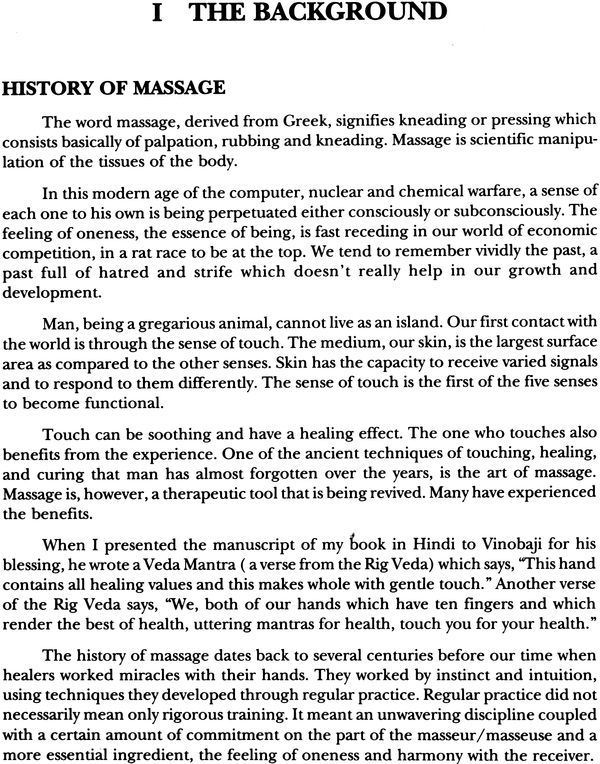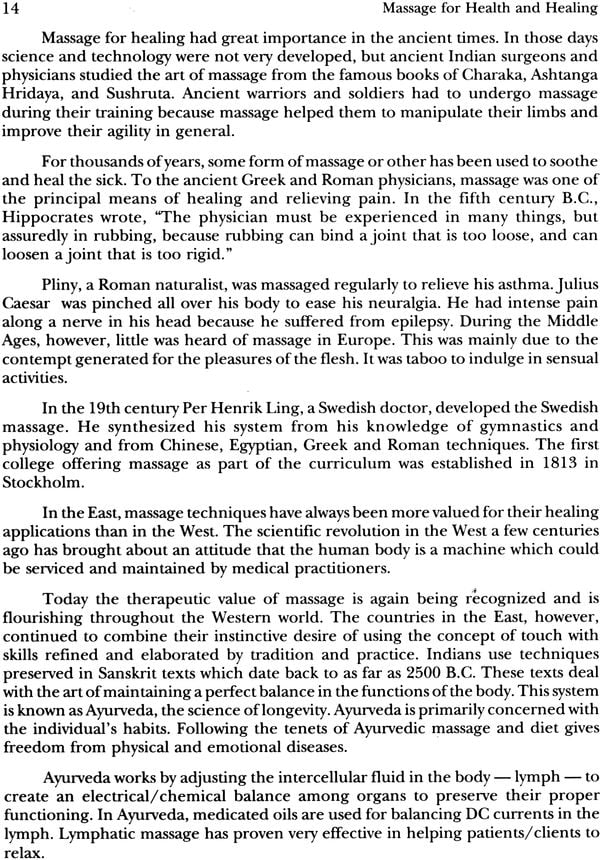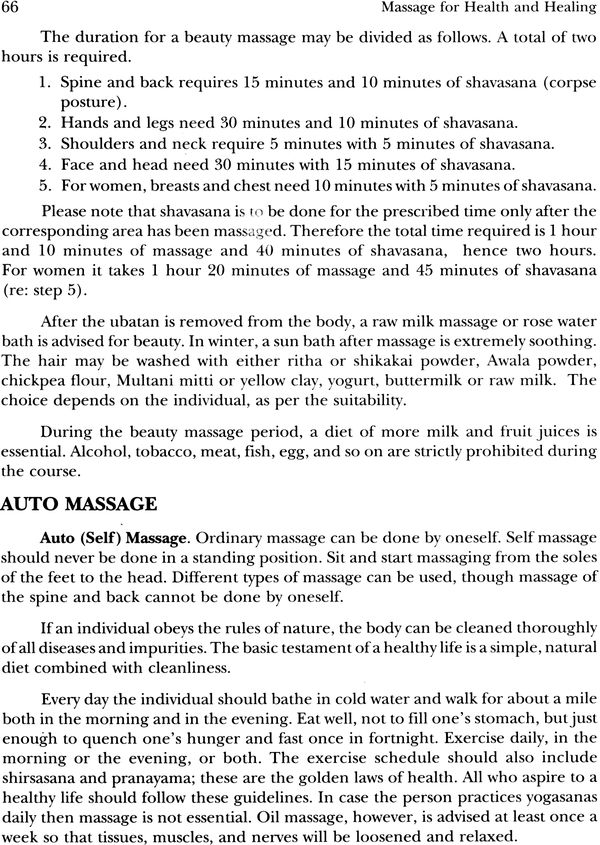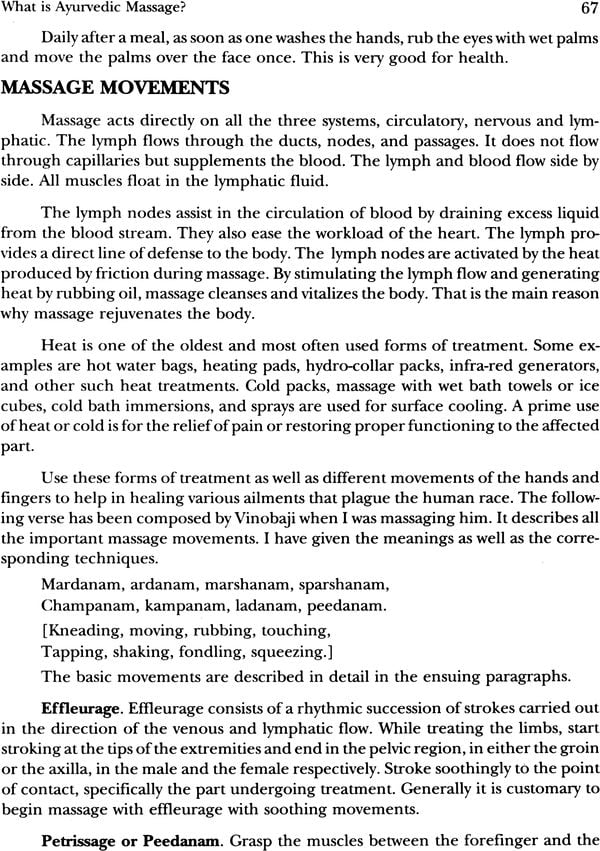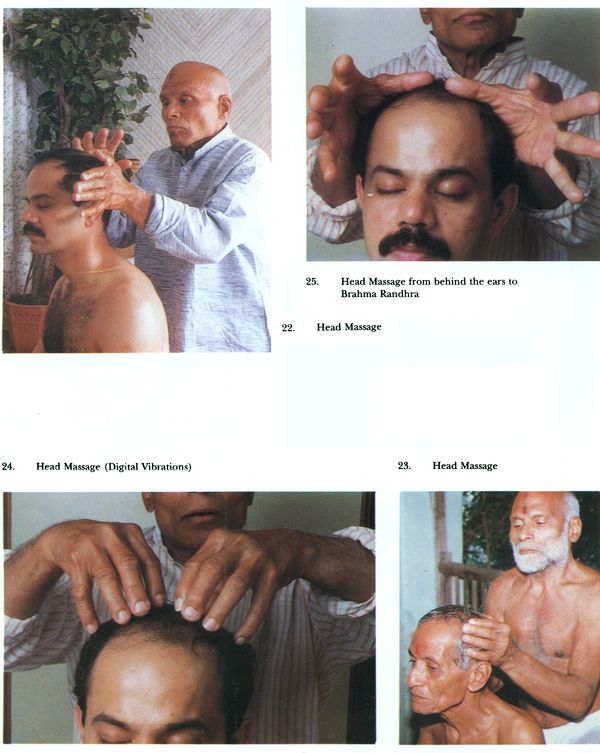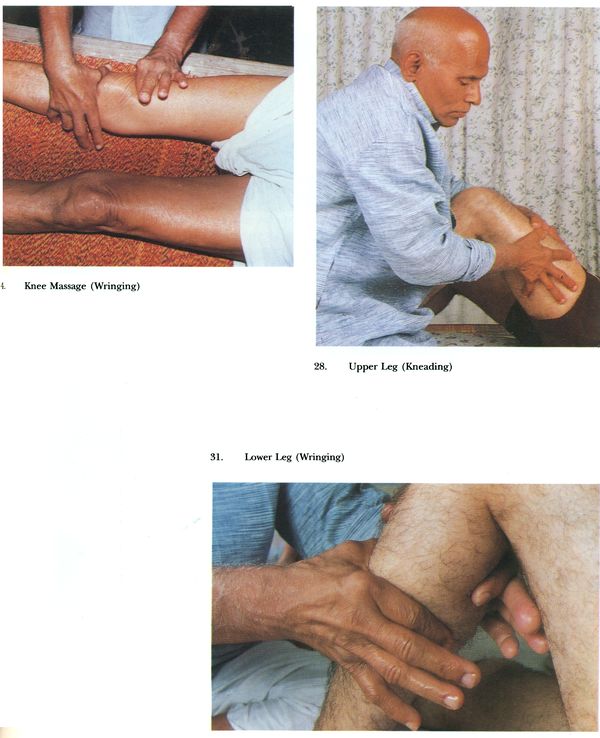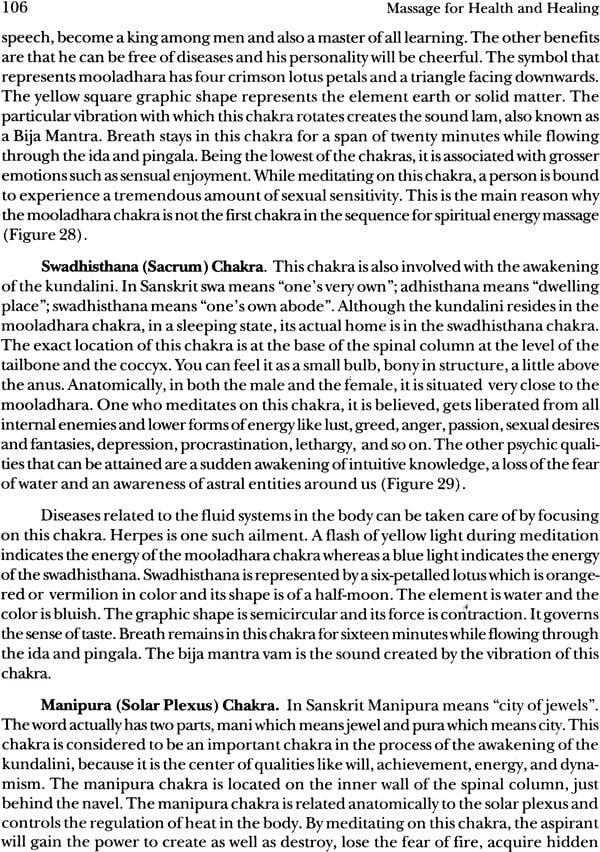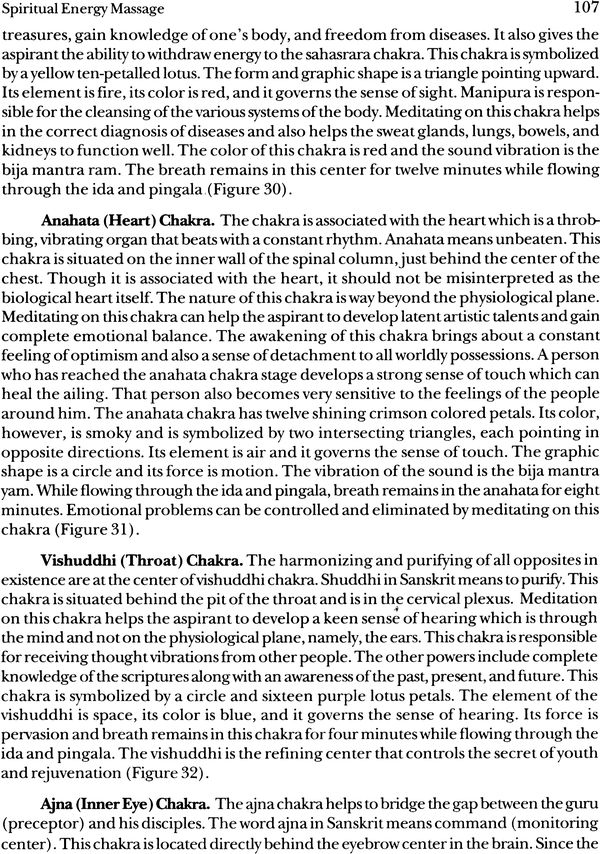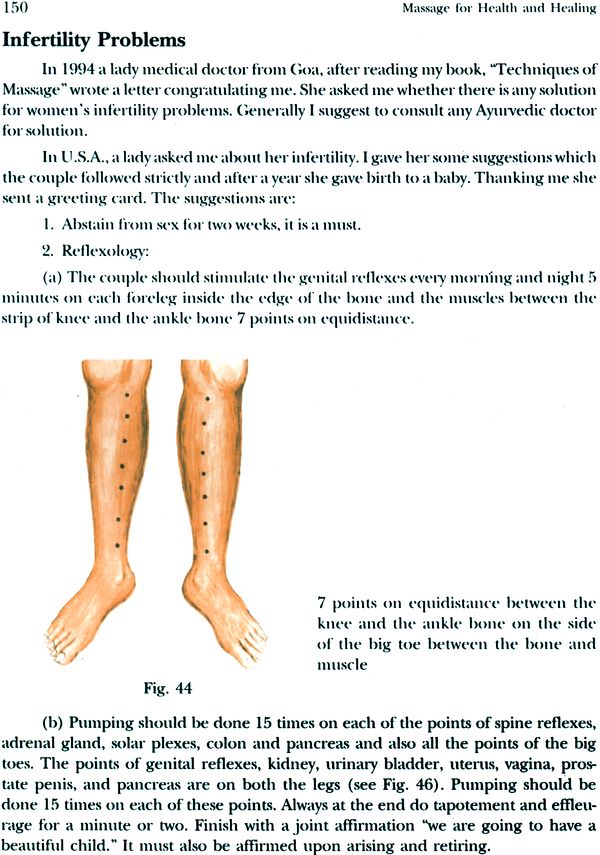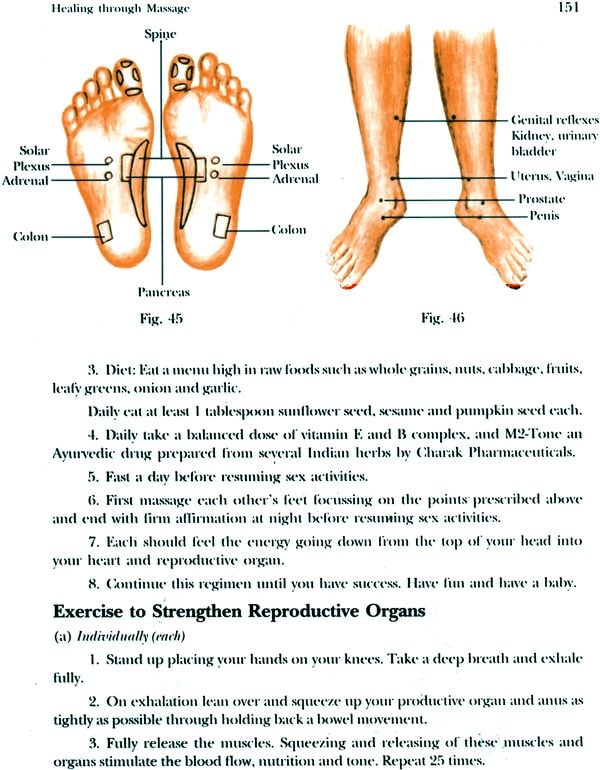
Ayurvedic Massage (For Health and Healing)
Book Specification
| Item Code: | IDE001 |
| Author: | S.V. Govindan |
| Publisher: | ABHINAV PUBLICATION |
| Language: | English |
| Edition: | 2019 |
| ISBN: | 9788170174851 |
| Pages: | 164 (Color Illus: 56, B & W Illus: 2, Figures (Color): 52) |
| Cover: | Hardcover |
| Other Details | 10.0" X 7.6" |
| Weight | 700 gm |
Book Description
This book on "Massage for Health and Healing: The Ayurvedic and Spiritual Energy Approach" is a commendable guide to a very important medical aid which reigned with dignity in the past. Though it was neglected for many years, the art of massage has recaptured its central place amongst the forms of healing. Prevention of disease, and promoting health.
Massage is the oldest of all techniques for relieving pain, shaping the organs, regenerating tissues, and correcting almost all internal malfunctions. Massage and its origin in the natural instincts of animals, handed over to the conscious man with a mandate to improve it as far as possible with his old wisdom. Despite advancements in knowledge and complex techniques, massage retains its usefulness and significance even as a method to save a person from immediate death, as in heart failure, breathlessness, and several other fatal ailments.
In all kinds of therapeutic approaches, massage alone can maintain certain links. Any method of treatment with a holistic approach cannot leave out massage. Ayurveda upholds its psychosomatic benefits. Sushruta and other texts explain it, classifying various types of massages and instructions on their manipulations and effects. In Ayurveda, the human body constitutes three functional entities, the balance of which maintains health; an upset in this balance increases disease.
The book serves not only as a guide to novice practitioners but also as a manual and refresher guide for those who are experienced ayurvedic masseurs. The contents (techniques) of this book will bring relief and better health to those who faithfully apply them in their daily lives.
The author, Shri S.V. Govindan, hails from the village Manassery in Ottapalan, situated in the Palghat district of Kerala in southern India. Born on December 24, 1924, Govindanji is the youngest son in a family of five children. He spent his childhood and adolescence in Kerala where he was educated by his brothers who were school teachers at the time. Govindanji has come a long way in gathering valuable experience not only as a teacher in various Khadi Vidyalayas in the country, but more so as an expert masseur with a healing and sympathetic hand.
Govindanji, a devoted social worker, is a disciple of Acharya Vinoba Bhave. He has been active in the field of Sarvodaya work for many years. The usefulness, scientific reliability, and simplicity of massage as a way to serve the masses attracted him. He wanted to help those for whom the conveninience and amenities of costly medicines were out of reach. The value of this useful technique is often overlooked, even by the enlightened. When Govindanji was initiated into this field of massage by none other thatn Shri K. Kelappan, a national leader from Kerala, he realized that it was one of his missions to promote this useful technique by study and propagation. By reading and observation he learned the theory and practice of massage. Encouraged by Vinobaji Bhave, Govindanji wrote his first publication in Hindi Maalish Ka Marma. The practicality of the book attracted many who were interested in this field. Many people read it and encouraged the author to bring out the English version of it.
(Free rendering of the preface written for the Malayalam version) My friend Sri S.V. Govindan is not mere a learned writer. In his early youth he was attracted by the ideals of Mahatma Gandhi and observing celibacy he proved himself as a true Satyagrahi doing constructive work for the welfare of the country. Now he is one of the old members of Vinoba’s Ashram, Brahma Vidya Mandir, Paunar. He strives to achieve the ultimate and tries to serve the human beings for their physical health and spiritual peace by doing massage.
He got this art from Kelappanji. Being a regular spinner he has travelled most of the European countries and U.S.A. and Canada to propagate massage. Wherever he goes, he collects a group of friends. This experienced person is ever learning and has written some books for the benefit of others.
With his own experience he has written a small book, Spiritual Energy Massage. All of us know the role of acupuncture, the system of Chinese treatment. From that acupressure is developed and it is very popular everywhere. The Spiritual Energy Massage is based on acupressure. But the specialty is that the author has written it with his own experience. Experience is more important than definitions and commentaries.
Today the medical science goes forward breaking its boundaries for achieving the ultimate progress. Holistic vision gives enthusiasm and strength for it. So it would be better if the modern medical scientists try to understand and accept it.
The conception of yoga-chakra and the effect of Ida-Pringala and Sushumna nerves are the gifts of our ancient Indian philosophy. Now these are the subjects of great scientists for observation and study. This ancient philosophy spread to China, from China to Japan, and then it got publicity in European countries and America. With its minute study the latest system of treatment could achieve ever new dimensions. Now again it was brought to India and we accept it as their new invention. Really that is what is happening today.
Sri S.V. Govindan’s Spiritual Energy Massage points out how far we could understand and accept such studies. I earnestly request the medical associations to read it carefully and understand. By its study, surely we will be benefited.
This book on “Massage for Health and Healing: The Ayurvedic and Spiritual Energy Approach” is a commendable guide to a very important medical aid which reigned with dignity in the past. Though it was neglected for many years, the art of massage has recaptured its central place amongst the forms of healing, prevention of disease, and promoting health. So I consider it a privilege and an honor to write a foreword to this timely publication.
“Govindanji” a devoted social worker, is a disciple of Acharya Vinoba Bhave. He has been active in the field of Sarvodaya work for many years. The usefulness, scientific reliability, and simplicity of massage as a way to serve the masses attracted him. He wanted to help those for whom the conveniences and amenities of costly medicines were out of reach. The value of this useful technique is often overlooked, even by the enlightened. When Govindanji was initiated into this field of massage by none other than Shri K Kelappan, a national leader from Kerala, he realized that it was one of his missions to promote this useful technique by study and propagation. By reading and observation he learned the theory and practice of massage. Encouraged by Vinobaji Bhave, Govindanji wrote his first publication in Hindi, Malish ka Marma. The practicality of the book attracted many who were interested in this field. Many people read it and encouraged the author to bring out this English version of it.
Massage is the oldest of all techniques for relieving pain, shaping the organs, regenerating tissues, and correcting almost all internal malfunctions. Massage has its origin in the natural instincts of animals, handed over to the conscious man with a mandate to improve it as far as possible with his old wisdom. Despite advancements in knowledge and complex techniques, massage retains its usefulness and significance even as a method to save a person from immediate death, as in heart failure, breathlessness, and several other fatal ailments.
In all kinds of therapeutic approaches, massage alone can maintain certain links. Any method of treatment with a holistic approach cannot leave out massage. Ayurveda upholds its psychosomatic benefits. Sushruta and other texts explain it, classifying various types of massages and instructions on their manipulations and effects. In Ayurveda, the human body constitutes three functional entities, the balance of which maintains health; an upset in this balance increases diseases. The vital life force, energy, or prana, is regulated by the peaceful co-existence of these functional entities. This has been explained very well in this book. Massage is the most useful technique; if used in a proper way, massage can sense the specialties of the parts of the body; it can be used to correct problems. Realizing the importance of massage, all special treatments in Kerala are formulated with a holistic approach to the body and mind and have proved their efficacy in healing many complicated diseases.
This book serves not only as a guide to novice practitioners but also as a manual and refresher guide for those who are experienced ayurvedic masseurs. The contents (techniques) of this book will bring relief and better health to those who faithfully apply them in their daily lives. I am sure all those who are devoted to the study of holistic approaches will certainly appreciate this work and the author. l recommend this work to all, including research scholars, physicians, practitioners, and social and cultural workers in India and abroad.
Staying healthy or becoming more healthy not only requires a positive outlook but also patient, consistent maintenance of the body through massage and a healthy diet. Exercise is also advised. This book tells you how to be healthier.
This book tells you the ways and means by which you can maintain optimum health. That is what this book is all about. I have covered various topics which have a lasting and positive value for us if followed patiently with love and compassion. The benefits for both the giver and the receiver are many.
As the title suggests, this book involves an art of healing through massage. Read the book once thoroughly, treating it like a novel. Then, depending on your level of interest, read the entire book again, slowly this time, reading chapter by chapter and assimilating the contents. As you read, practice the art of massage on your spouse, parents, other relatives, or friends.
Please remember that you are entirely responsible for your health and well-being. All therapies and techniques mentioned in this book are to be adopted and followed strictly after you have consulted your personal physician.
Massage is the manipulation of the soft tissues of the body. All the theories of massage are scientific, but their application is an art developed by the individual. The masseur/masseuse should increase his/her knowledge about anatomy and physiology, shiatsu, and acupressure in addition to carefully reading and practicing the contents of this book.
A skillful masseur/masseuse should be able to devise, in the course of his practice, better ways and means for the actual application of the various techniques. Like an artist from any discipline, a masseur/masseuse can develop his/her own style of massage but based on the basics. Hard work and regular, disciplined practice are essential. If the masseur/masseuse continues to develop his/her fingers and the sensitivity of their touch, he/she can gain dexterity that will make it possible to manipulate hidden muscles as effectively as if they were visible or on the surface of the body.
This art of massage is a God-send. The aspirant may make use of this opportunity to develop a sense of giving so that he or she is able to render a simple, yet valuable service to humanity, especially those in need. I hope you enjoy reading this book as much as I have enjoyed writing it for you.
| Dedication | 5 | |
| Foreword | 9 | |
| Introduction
| 11 | |
| I | THE BACKGROUND | |
| History of Massage | 13 | |
| Human Physiology | 17 | |
| Science of Marma (Vital Areas)
| 23 | |
| II | WHAT IS AYURVEDIC MASSAGE | |
| What is Ayurveda ? | 29 | |
| Benefits and General Guidelines of Massage | 35 | |
| Cold Massage | 60 | |
| Beauty Massage for Women and Men | 60 | |
| Auto Massage | 66 | |
| Massage Movements | 67 | |
| Oils, Pastes and Essences | 71 | |
| Colors and their Effects | 77 | |
| Urine Therapy Massage | 80 | |
| Benefits of Ayurvedic Massage | 83 | |
| Ayurvedic Massages of Kerala: Pizhichil, Navarakkizhi, Dhara | 85 | |
| Doing Massage with Legs
| 88 | |
| III | HEALING THROUGH MASSAGE | |
| Case Study Summaries | 89 | |
| Healing through Massage | 90 | |
| Ayurvedic Herbs and Food Combinations
| 95 | |
| IV | SPIRITUAL ENERGY MASSAGE | |
| Kundalini | 103 | |
| Chakras | 104 | |
| Chakras and the Endocrine Glands | 109 | |
| Techniques of Spiritual Energy Massage
| 112 | |
| Appendix A: | ||
| Acupressure | 121 | |
| Reflexology (Zone Therapy)
| 126 | |
| Appendix B | 133 | |
| Bibliography | 159 | |
| Index | 160 |
